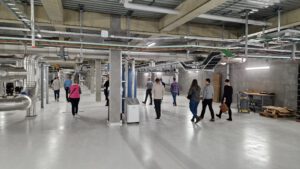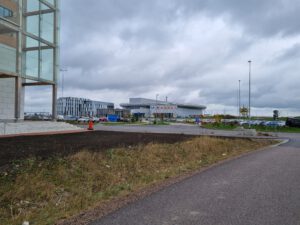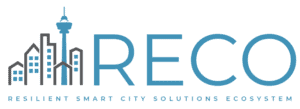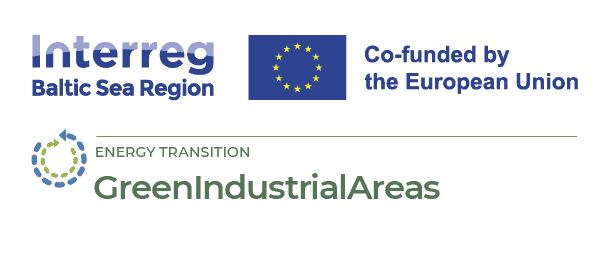
Study Trip to Sweden and Denmark
26 November 2024
In late October, a Finnish expert group conducted a study trip to Sweden and Denmark, where they explored the latest energy solutions and sustainable urban planning practices. The tour included representatives from Helsinki, Vantaa, Tampere, and Jyväskylä, as well as participants from Helen, Vantaa Energy, and Tampere Energy. Several projects, such as GreenIndustrialAreas, Promoting open innovation in the built environment – from innovation to practice, RECO 2.0, DALI, ENPA and Treasource, were also represented.
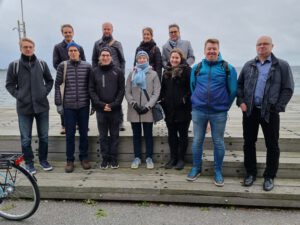
Malmö, October 31, 2024 – Västrahamnen and Nyhamnen
In the morning, Malmö city representatives introduced the Västrahamnen area, where the design emphasizes renewable energy and sustainable mobility solutions. The area’s energy is generated from solar and wind power, geothermal energy, and biogas. The biogas is produced from bio-waste collected in the area and transported to storage through a piped biowaste collection system. In Västrahamnen’s urban design, the traditional grid plan has been broken up to reduce the impact of coastal winds, and the stormwater system incorporates visible art elements that enhance the urban aesthetic. Sustainable mobility solutions prioritize car-free access and cycling: parking is centralized, and large elevators are specifically designed to accommodate cyclists.
The group later visited the developing port area of Nyhamnen, which is still in the planning stages. In the next phase of the project, parts of the port basins will be filled to support the revitalization of local vegetation and ecosystems. The area is expected to be completed by the 2040s–2050s.
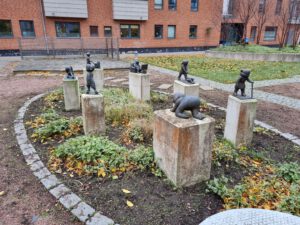
Lund, October 31, 2024 – Brunnshög and Medicon Village
In the afternoon, the group travelled to Lund, where representatives from Kraftkringen and the City of Lund introduced the Brunnshög area and its low-temperature district heating system. Much of the area’s heat is generated from the waste heat of two particle accelerators. Brunnshög’s cooling system uses absorption technology that utilizes excess heat energy. Additionally, a new CHP plant powered by biomass is planned. The facility, built by Kraftkringen, will produce both electricity and heat, supplying steam to a local sugar factory. The CHP investment was motivated by wintertime electricity sufficiency concerns in the Skåne region, and the biomass plant will provide the area with needed energy security. Simultaneously, the existing geothermal heat pump plant will be phased out. To promote sustainable development, a points-based land allocation system (bronze, silver, and gold) is used for the area.
Finally, the group visited Medicon Village, where E. ON’s Ectogrid system is in use. This innovative, low-temperature district heating system enables the efficient transfer of heating and cooling between buildings. Each building is equipped with heat pumps to provide the required heating and cooling, while the very low-temperature heat transfer network optimizes energy use. The system is smartly managed through a cloud-based system called ectocloud, maximizing energy efficiency and adapting to real-time energy needs of the properties.
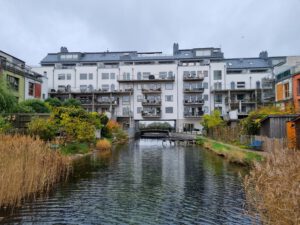
Copenhagen, November 1, 2024 – Nordhavn and Bispebjerg Hospital
On the final day, the group visited Copenhagen to explore the Nordhavn area’s development and HOFOR’s energy solutions. In Nordhavn, which is designed to accommodate housing for 40,000 residents, energy is produced through seawater heat and an aquifer thermal energy storage (ATES) system. Groundwater can be efficiently used for heat production in the Copenhagen area, as it is not used for drinking water. Additionally, HOFOR maintains CHP plants that utilize biomass and waste incineration for energy production. Following the Nordhavn visit, the group toured the Bispebjerg Hospital area to gain more insights into the ATES system. This system can generate more energy at a lower investment cost compared to conventional geothermal systems.
The insights from the tour will be beneficial for projects like Green Industrial Areas, as sustainable energy solutions also support industrial area development. Project Manager Timi Tiira summarized the tour’s key takeaways: “The tour provided excellent examples of sustainable development and energy solutions that could also be applied in Finland.”
